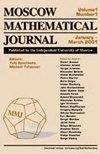余维为1的反全纯抛物不动点的一般展开的解析分类
IF 0.5
4区 数学
Q3 MATHEMATICS
引用次数: 1
摘要
我们对共轭条件下具有余维为1的抛物点(即双不动点)的反全纯微分同胚的一般展开进行了分类。这些泛型展开依赖于一个实参数。分类是通过分配给每个这样的胚芽一个弱模和一个强模来完成的,这是分配给反全纯抛物点的模的展开。弱模和强模是胚芽第二次迭代的Ecalle-Voronin模的展开,它是全纯抛物点的实展开。展开的制备允许识别一个实解析正则参数,并且两个制备的一般展开之间的任何共轭都保留正则参数。给出了实现强模的充分必要条件,解决了实现问题。同时解决了全纯抛物型胚的一般解析展开的一个胚的反全纯平方根的存在性问题。作为第二个应用,我们建立了实解析不变曲线存在的条件。本文章由计算机程序翻译,如有差异,请以英文原文为准。
Analytic Classification of Generic Unfoldings of Antiholomorphic Parabolic Fixed Points of Codimension 1
We classify generic unfoldings of germs of antiholomorphic diffeomorphisms with a parabolic point of codimension 1 (i.e. a double fixed point) under conjugacy. These generic unfolding depend on one real parameter. The classification is done by assigning to each such germ a weak and a strong modulus, which are unfoldings of the modulus assigned to the antiholomorphic parabolic point. The weak and the strong moduli are unfoldings of the \'Ecalle-Voronin modulus of the second iterate of the germ which is a real unfolding of a holomorphic parabolic point. A preparation of the unfolding allows to identify one real analytic canonical parameter and any conjugacy between two prepared generic unfoldings preserves the canonical parameter. We also solve the realisation problem by giving necessary and sufficient conditions for a strong modulus to be realized. This is done simultaneously with solving the probem of the existence of an antiholomorphic square root to a germ of generic analytic unfolding of a holomorphic parabolic germ. As a second application we establish the condition for the existence of a real analytic invariant curve.
求助全文
通过发布文献求助,成功后即可免费获取论文全文。
去求助
来源期刊
CiteScore
1.40
自引率
0.00%
发文量
16
审稿时长
>12 weeks
期刊介绍:
The Moscow Mathematical Journal (MMJ) is an international quarterly published (paper and electronic) by the Independent University of Moscow and the department of mathematics of the Higher School of Economics, and distributed by the American Mathematical Society. MMJ presents highest quality research and research-expository papers in mathematics from all over the world. Its purpose is to bring together different branches of our science and to achieve the broadest possible outlook on mathematics, characteristic of the Moscow mathematical school in general and of the Independent University of Moscow in particular.
An important specific trait of the journal is that it especially encourages research-expository papers, which must contain new important results and include detailed introductions, placing the achievements in the context of other studies and explaining the motivation behind the research. The aim is to make the articles — at least the formulation of the main results and their significance — understandable to a wide mathematical audience rather than to a narrow class of specialists.

 求助内容:
求助内容: 应助结果提醒方式:
应助结果提醒方式:


